6th Edition Jonathan L. Portny
Visit to download the full and correct content document: https://ebookmass.com/product/project-management-for-dummies-6th-edition-jonatha n-l-portny/
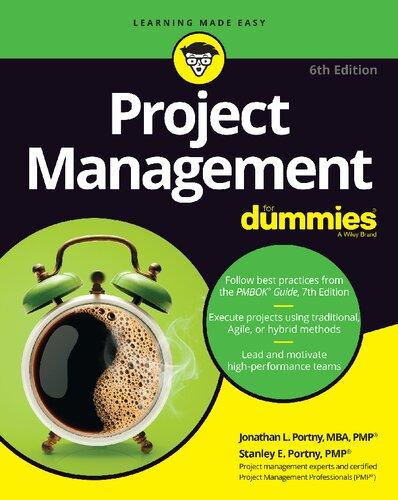
More products digital (pdf, epub, mobi) instant download maybe you interests ...
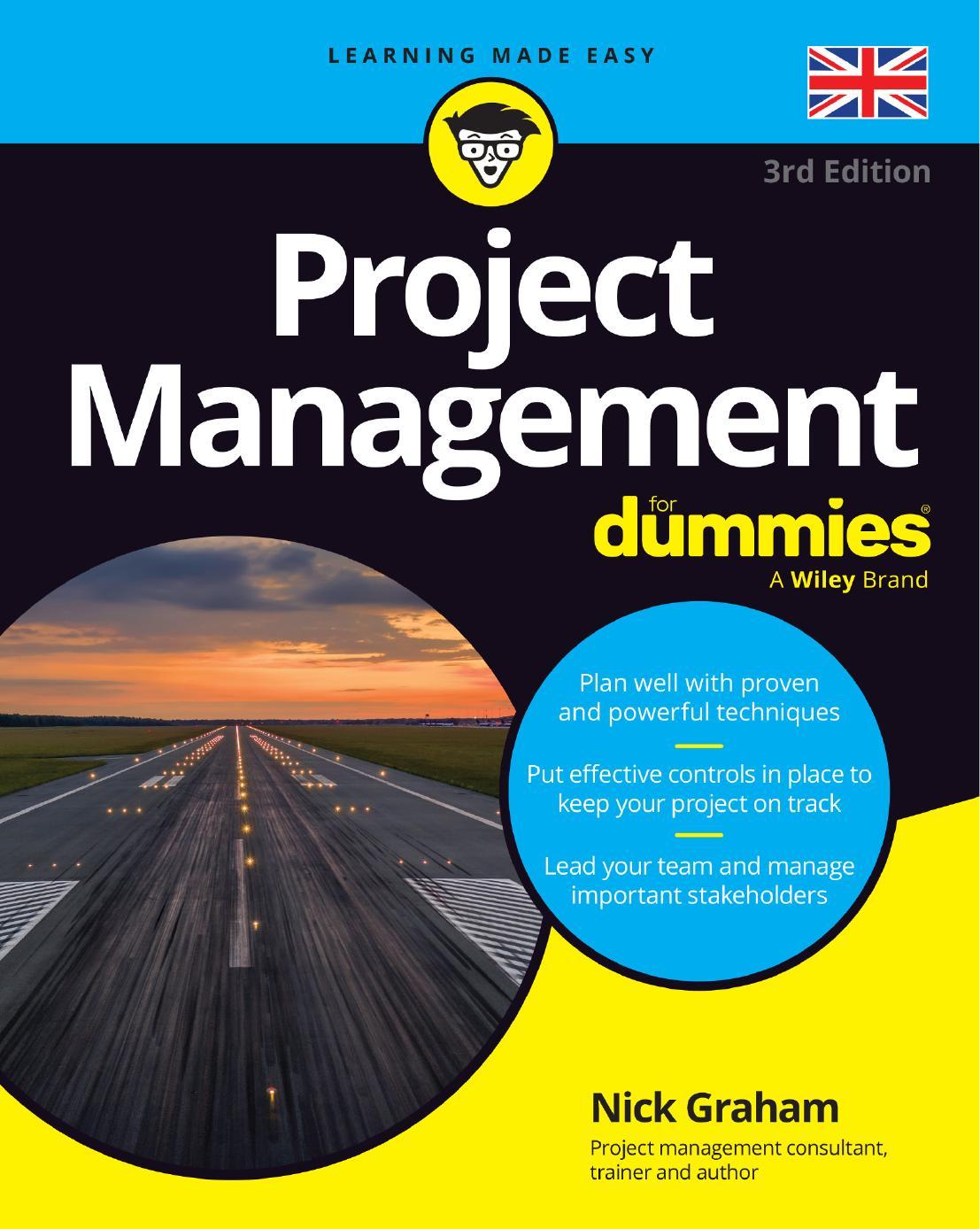
Project Management For Dummies®, 3rd Edition UK Edition
Nick Graham
https://ebookmass.com/product/project-management-for-dummies-3rdedition-uk-edition-nick-graham/
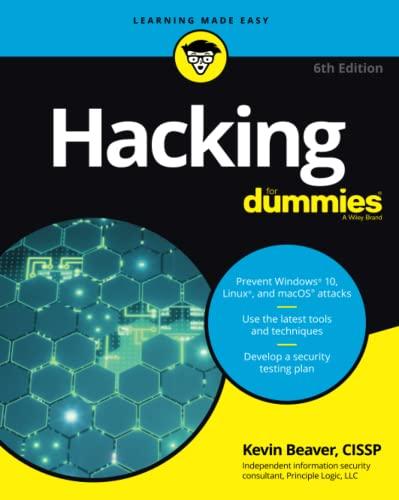
Hacking For Dummies (For Dummies (Computer/Tech)) 7th Edition Beaver
https://ebookmass.com/product/hacking-for-dummies-for-dummiescomputer-tech-7th-edition-beaver/

Microsoft Project For Dummies Cynthia Snyder Dionisio
https://ebookmass.com/product/microsoft-project-for-dummiescynthia-snyder-dionisio/
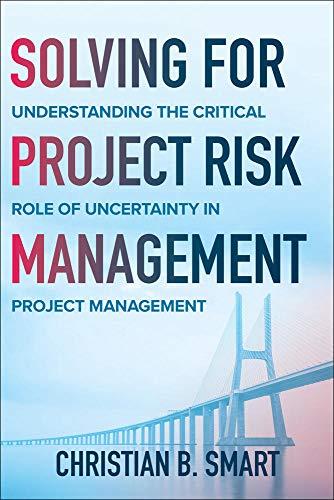
Solving for Project Risk Management: Understanding the Critical Role of Uncertainty in Project Management 1st Edition Smart
https://ebookmass.com/product/solving-for-project-riskmanagement-understanding-the-critical-role-of-uncertainty-inproject-management-1st-edition-smart/
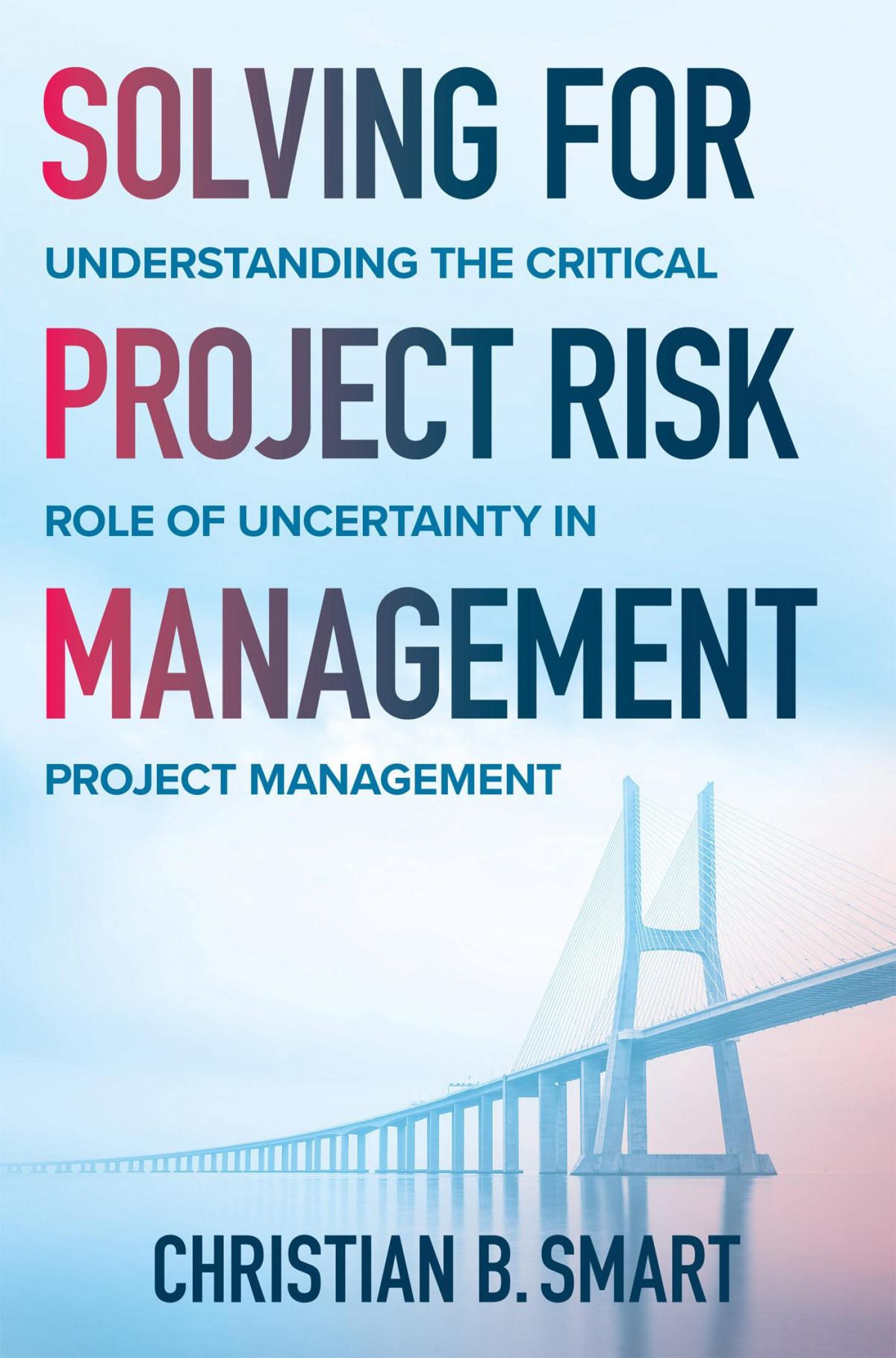
Solving for Project Risk Management Christian Smart
https://ebookmass.com/product/solving-for-project-riskmanagement-christian-smart-3/
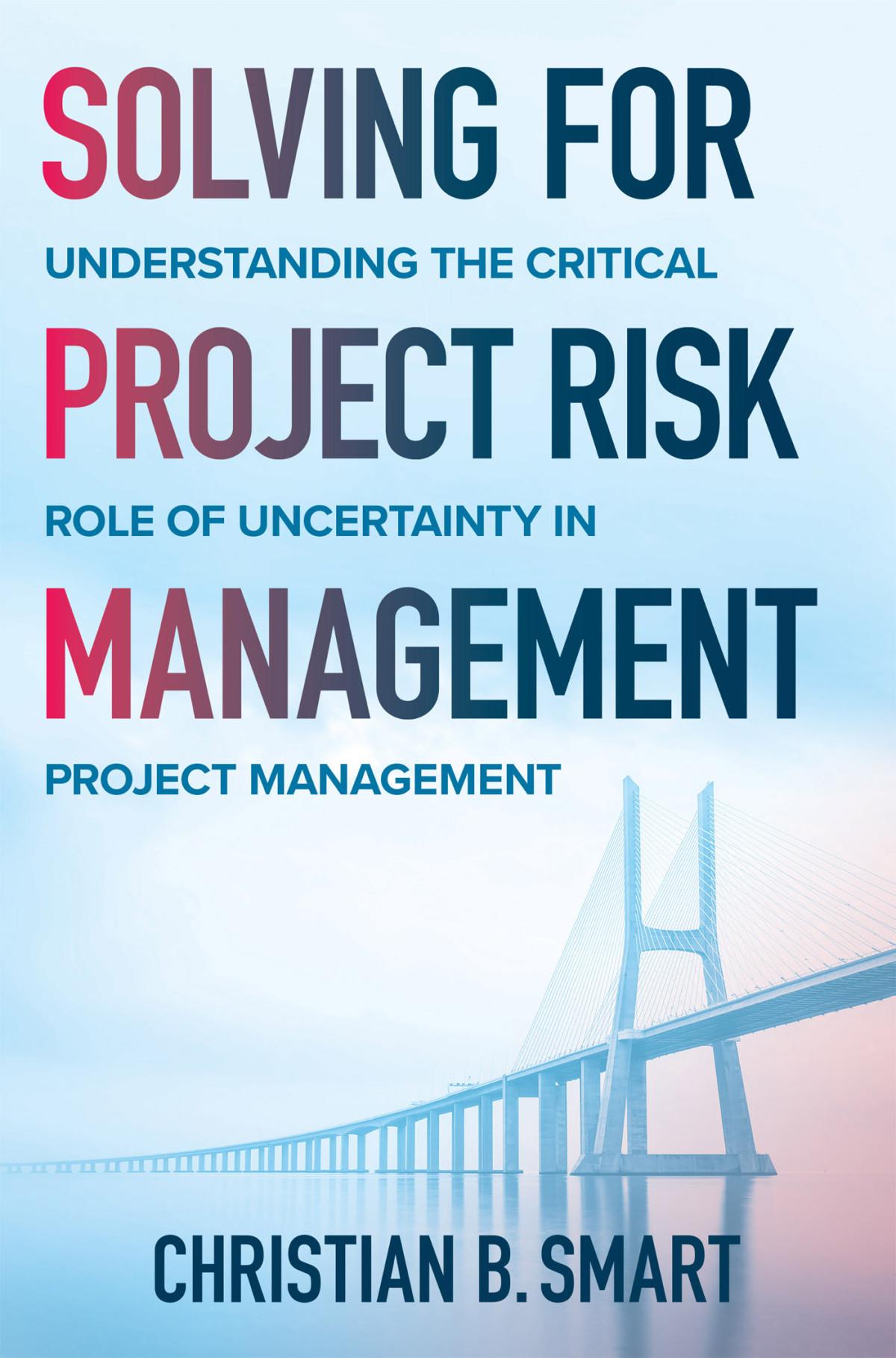
SOLVING FOR PROJECT RISK MANAGEMENT Christian Smart
https://ebookmass.com/product/solving-for-project-riskmanagement-christian-smart/
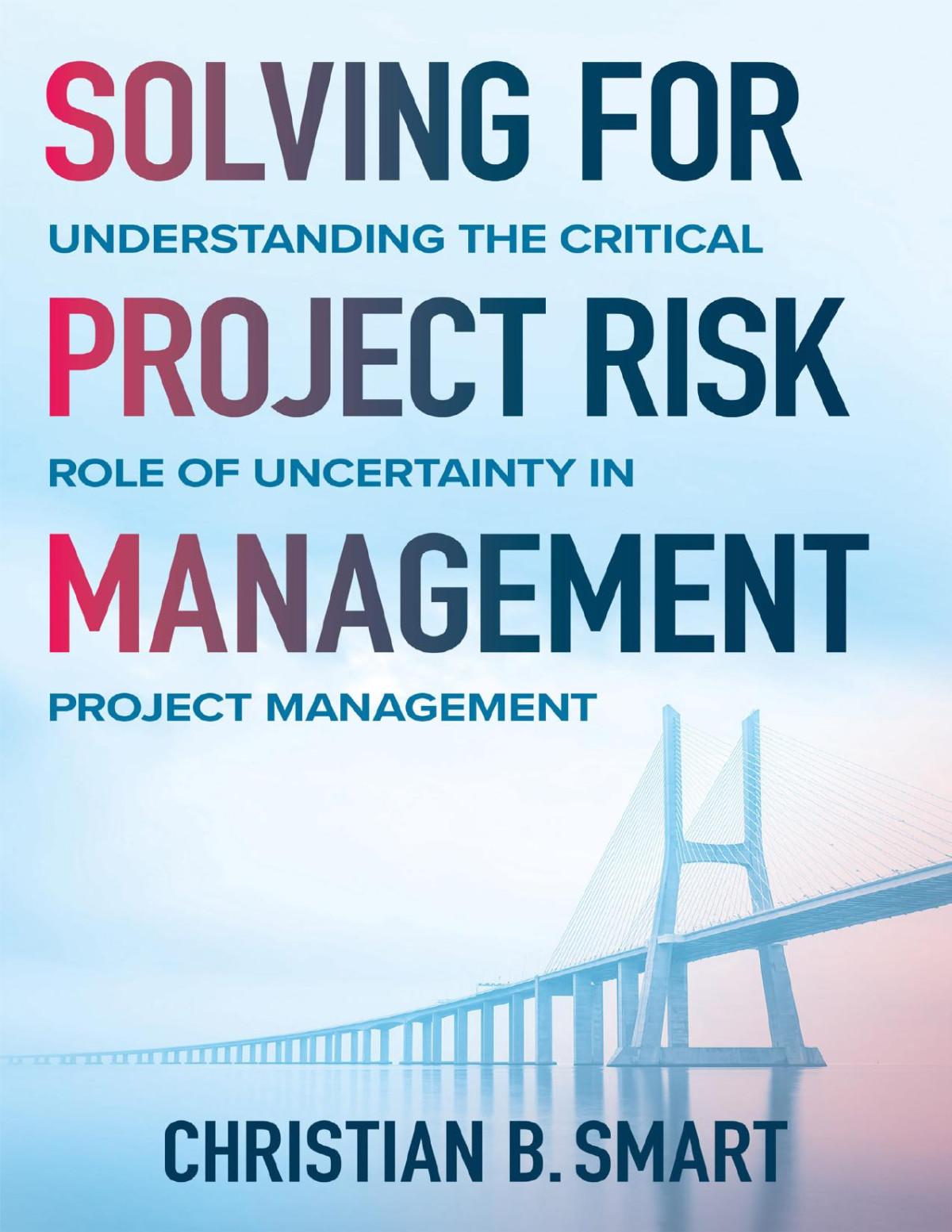
Solving for Project Risk Management Christian Smart
https://ebookmass.com/product/solving-for-project-riskmanagement-christian-smart-2/

Diabetes For Dummies 6th Edition Simon Poole
https://ebookmass.com/product/diabetes-for-dummies-6th-editionsimon-poole/
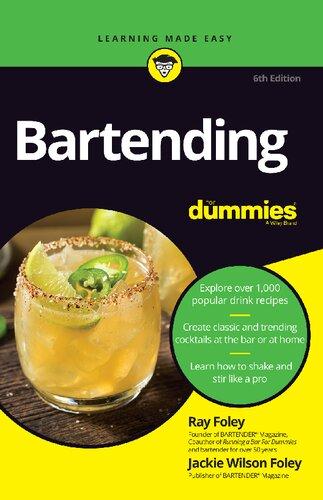
Bartending For Dummies, 6th Edition Ray Foley
https://ebookmass.com/product/bartending-for-dummies-6th-editionray-foley/
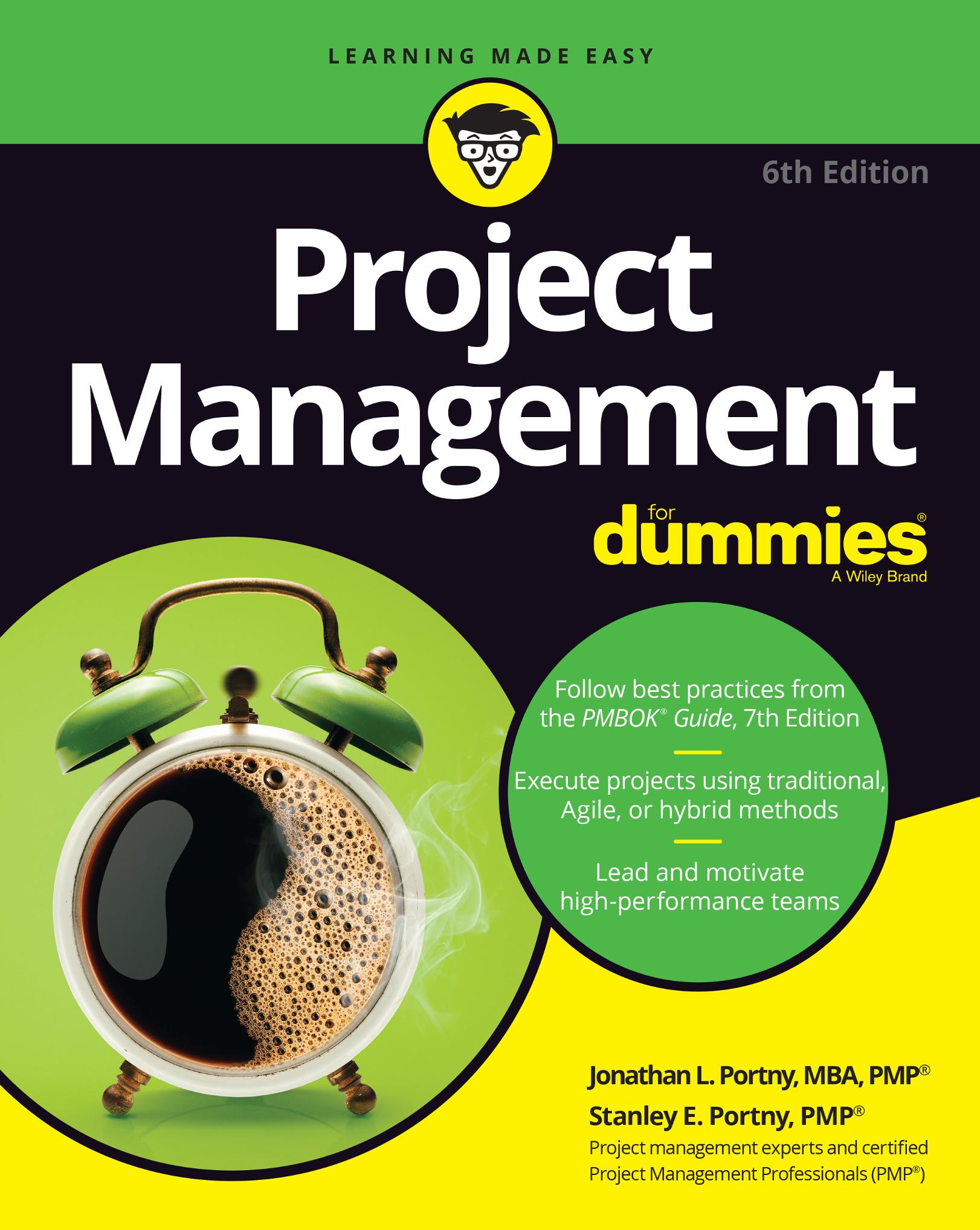
Project Management
6th Edition
by Jonathan L. Portny, MBA, PMP®
Certified Project Management Professional (PMP®)
Stanley E. Portny, PMP®
Certified Project Management Professional (PMP®)
Project Management For Dummies®, 6th Edition
Published by: John Wiley & Sons, Inc., 111 River Street, Hoboken, NJ 07030-5774, www.wiley.com
Copyright © 2022 by John Wiley & Sons, Inc., Hoboken, New Jersey
Published simultaneously in Canada
No part of this publication may be reproduced, stored in a retrieval system or transmitted in any form or by any means, electronic, mechanical, photocopying, recording, scanning or otherwise, except as permitted under Sections 107 or 108 of the 1976 United States Copyright Act, without the prior written permission of the Publisher. Requests to the Publisher for permission should be addressed to the Permissions Department, John Wiley & Sons, Inc., 111 River Street, Hoboken, NJ 07030, (201) 748-6011, fax (201) 748-6008, or online at http://www.wiley.com/go/ permissions.
Trademarks: Wiley, For Dummies, the Dummies Man logo, Dummies.com, Making Everything Easier, and related trade dress are trademarks or registered trademarks of John Wiley & Sons, Inc., and may not be used without written permission. All other trademarks are the property of their respective owners. John Wiley & Sons, Inc., is not associated with any product or vendor mentioned in this book.
LIMIT OF LIABILITY/DISCLAIMER OF WARRANTY: WHILE THE PUBLISHER AND AUTHORS HAVE USED THEIR BEST EFFORTS IN PREPARING THIS WORK, THEY MAKE NO REPRESENTATIONS OR WARRANTIES WITH RESPECT TO THE ACCURACY OR COMPLETENESS OF THE CONTENTS OF THIS WORK AND SPECIFICALLY DISCLAIM ALL WARRANTIES, INCLUDING WITHOUT LIMITATION ANY IMPLIED WARRANTIES OF MERCHANTABILITY OR FITNESS FOR A PARTICULAR PURPOSE. NO WARRANTY MAY BE CREATED OR EXTENDED BY SALES REPRESENTATIVES, WRITTEN SALES MATERIALS OR PROMOTIONAL STATEMENTS FOR THIS WORK. THE FACT THAT AN ORGANIZATION, WEBSITE, OR PRODUCT IS REFERRED TO IN THIS WORK AS A CITATION AND/OR POTENTIAL SOURCE OF FURTHER INFORMATION DOES NOT MEAN THAT THE PUBLISHER AND AUTHORS ENDORSE THE INFORMATION OR SERVICES THE ORGANIZATION, WEBSITE, OR PRODUCT MAY PROVIDE OR RECOMMENDATIONS IT MAY MAKE. THIS WORK IS SOLD WITH THE UNDERSTANDING THAT THE PUBLISHER IS NOT ENGAGED IN RENDERING PROFESSIONAL SERVICES. THE ADVICE AND STRATEGIES CONTAINED HEREIN MAY NOT BE SUITABLE FOR YOUR SITUATION. YOU SHOULD CONSULT WITH A SPECIALIST WHERE APPROPRIATE. FURTHER, READERS SHOULD BE AWARE THAT WEBSITES LISTED IN THIS WORK MAY HAVE CHANGED OR DISAPPEARED BETWEEN WHEN THIS WORK WAS WRITTEN AND WHEN IT IS READ. NEITHER THE PUBLISHER NOR AUTHORS SHALL BE LIABLE FOR ANY LOSS OF PROFIT OR ANY OTHER COMMERCIAL DAMAGES, INCLUDING BUT NOT LIMITED TO SPECIAL, INCIDENTAL, CONSEQUENTIAL, OR OTHER DAMAGES.
For general information on our other products and services, please contact our Customer Care Department within the U.S. at 877-762-2974, outside the U.S. at 317-572-3993, or fax 317-572-4002. For technical support, please visit https://hub.wiley.com/community/support/dummies
Wiley publishes in a variety of print and electronic formats and by print-on-demand. Some material included with standard print versions of this book may not be included in e-books or in print-on-demand. If this book refers to media such as a CD or DVD that is not included in the version you purchased, you may download this material at http://booksupport.wiley.com. For more information about Wiley products, visit www.wiley.com.
Library of Congress Control Number: 2022932726
ISBN 978-1-119-86981-8 (pbk); ISBN 978-1-119-86991-7 (ebk); ISBN 978-1-119-86982-5 (ebk)
Gaining a micromanager’s trust
Updating your initial closure plans when you’re ready to wind down the
Charging up your team for the sprint to the finish
PART 5: TAKING YOUR PROJECT MANAGEMENT
Introduction
Projects have been around since ancient times. Noah building the ark, Leonardo da Vinci painting the Mona Lisa, J.R.R. Tolkien writing The Hobbit, Moderna and Pfizer developing their COVID-19 vaccines — all projects. And as you know, these were all masterful successes. Well, the products were a spectacular success, even if schedules and resource budgets were drastically overrun!
Why, then, is the topic of project management of such great interest today? The answer is simple: The audience has changed and the stakes are higher.
Historically, projects were large, complex undertakings. The first project to use modern project management techniques — the Polaris weapons system in the early 1950s — was a technical and administrative nightmare. Teams of specialists planned and tracked the myriad of research, development, and production activities. They produced mountains of paper to document the intricate work. As a result, people started to view project management as a highly technical discipline with confusing charts and graphs; they saw it as inordinately specialist-driven and definitely off-limits for the common person!
Because of the growing array of huge, complex, and technically challenging projects in today’s world, people who want to devote their careers to planning and managing those projects are vital to their successes. Over the past 30 to 35 years, the number of projects in the regular workplace has skyrocketed. Projects of all types and sizes are now the way that organizations accomplish their work.
At the same time, a new breed of project manager has emerged. This new breed may not have set career goals to become project managers — many among them don’t even consider themselves to be project managers, at least not as their primary role. But they do know they must successfully manage projects to move ahead in their careers. Clearly, project management has become a critical skill, not a career choice.
Even though these people realize they need special tools, techniques, and knowledge to handle their new types of assignments, they may not be able to devote large amounts of time to acquiring them without adversely impacting other responsibilities, which is where this book comes into play. This book is devoted to this silent majority of project managers.
About This Book
This book helps you recognize that the basic tenets of successful project management are simple. The most complex analytical technique takes less than ten minutes to master! In this book, we discuss information that’s necessary to plan and manage projects and provide important guidelines for developing and using this information. Here, you discover that the real challenge to a successful project is dealing with the multitude of people whom the project may affect or need for support. There are plenty of tips, hints, and guidelines for identifying key players and then involving them.
But knowledge alone won’t make you a successful project manager — you need to apply it. This book’s theme is that project management skills and techniques aren’t burdensome tasks you perform because some process requires it. Rather, they’re a way of thinking, communicating, and behaving. They’re an integral part of how we approach all aspects of our work every day.
So this book is intended to be direct and (relatively) easy to understand. But don’t be misled — the simple text still navigates all the critical tools and techniques you’ll need to support your project planning, scheduling, budgeting, organizing, and controlling. So buckle up!
This information is presented in a logical and modular progression. Examples and illustrations are plentiful — so are the tips and hints. And we (attempt to) inject humor from time to time to keep it all in perspective. The goal is that you finish reading this book feeling that good project management is a necessity and that you’re determined to practice it!
Of course, we want you to read every single word in this book, but we understand your life is busy and you may have time to read only what’s immediately relevant to you. In that case, feel free to skip the sidebars. Although the sidebars offer interesting, real-life stories of our own experiences, they’re not vital to grasping the concepts.
Foolish Assumptions
When writing this book, we assumed that a widely diverse group of people would read it, including the following:
» Senior managers and junior-level staff (who’ll become tomorrow’s senior managers)
» Experienced project managers and people who’ve never been on a project team
» People who’ve had significant project management training and people who’ve had none whatsoever
» People who’ve had years of real-world business and government experience and people who’ve only recently entered the workforce
After reading this book, we hope you wonder (and rightfully so) why all projects aren’t well-managed — because you’ll think these techniques are so logical, straightforward, and easy to use. But we also assume you recognize there’s a big difference between knowing what to do and doing it. We assume you realize you’ll have to work hard to overcome the forces that conspire to prevent you from using these tools and techniques.
Finally, we assume you’ll realize that you can read this book repeatedly and learn something new and different each time. Think of this book as a comfortable resource that has more to share as you experience new situations.
Icons Used in This Book
We include small icons in the left margins of the book to alert you to special information in the text. Here’s what they mean:
We use this icon to point out important information you should keep in mind as you apply the techniques and approaches.
This icon highlights techniques or approaches you can use to improve your project management practices.
This icon highlights potential pitfalls and danger spots that you should attempt to avoid or be prepared to address if they come to fruition.
Beyond the Book
In addition to the material in the print or e-book you’re reading right now, you can access free companion materials online. Simply navigate to www.dummies.com and search for “Project Management For Dummies Cheat Sheet.” From there you’ll be able to read or print several useful articles about confirming your project’s justification, developing meaningful project objectives, developing achievable project schedules, eliciting and sustaining commitment for projects, holding people accountable, and avoiding common project pitfalls.
Where to Go from Here
You can read this book in many ways, depending on your own project management knowledge and experience and your current needs. However, we suggest you first take a minute to scan the table of contents and thumb through the parts of the book to get a feeling for the topics we cover.
If you’re new to project management and are just beginning to form a plan for a project, first read Parts 1 and 2, which explain how to plan outcomes, activities, schedules, and resources. If you want to find out how to identify and organize your project’s team and other key people, start with Part 3. If you’re ready to begin work or you’re already in the midst of your project, you may want to start with Part 4. Or feel free to jump back and forth, hitting the chapters with topics that interest you the most.
The most widely recognized reference of project management best practices is A Guide to the Project Management Body of Knowledge (PMBOK), published by the Project Management Institute (PMI). The seventh and most recent edition of PMBOK (PMBOK 7) was published in 2021. The Project Management Professional (PMP) certification — the most recognized project management credential throughout the world — includes an examination (administered by PMI) with questions based on PMBOK 7.
Because we base this book on best practices for project management activities, the tools and techniques we cover are in accordance with PMBOK 7. However, if you’re preparing to take the PMP examination, use this book as a companion to PMBOK 7, not as a substitute for it.
As you read this book, keep the following points in mind:
» PMBOK 7 identifies what best practices are but doesn’t address in detail how to perform them or deal with difficulties you may encounter as you try to perform them. In contrast, this book focuses heavily on how to perform these project management techniques and processes.
» We’ve revised and updated the book so that all the tools and techniques discussed and all the terminology used to describe those tools and techniques are in agreement with those used in PMBOK 7 and, when possible, prior PMBOK editions.
» Where appropriate, we include a section at the end of each chapter that specifies where the topics in the chapter are addressed in PMBOK 7.
» PMBOK 7 often contains highly technical language and detailed processes, which people mistakenly dismiss as being relevant only for larger projects. This book, however, deliberately frames terms and discussions to be userfriendly. As a result, people who work on projects of all sizes can understand how to apply the tools and techniques presented.
No matter how you make your way through this book, plan on reading all the chapters more than once — the more you read a chapter, the more sense its approaches and techniques will make. And who knows? A change in your job responsibilities may create a need for certain techniques you’ve never used before. Enjoy and good luck!
1 Getting Started with Project Management
Discover what project management is all about and whether you have what it takes to be a successful project manager.
Learn about the changes to A Guide to the Project Management Body of Knowledge, 7th Edition (PMBOK 7) from the prior edition and the rationale for the substantial overhaul.
Check out the documents you need to assess a project’s feasibility and desirability, including the business case, the project charter, the preliminary stakeholder register, and the preliminary assumptions list. Consider how the data generated from a preliminary needs assessment, a feasibility study, and a cost-benefit analysis generate information needed to support the decision of whether to consider a proposed project further.
Find out how to identify people who may need to be involved in your project, and decide whether, when, and how to involve them. After you know who should be involved, determine who has the authority, power, and interest to make critical decisions along the way.
Think about the big picture of what your project is trying to accomplish (and why). Then get the scoop on writing a scope statement to confirm the results your project will produce and the constraints and assumptions under which everyone will work.
Outline the work you have to do to meet the expectations for your project, and find out how to break that work down into manageable chunks.
IN THIS CHAPTER
» Defining a project and its four phases
» Breaking down project management
» Shifting from process-based to principles-based project management
» Determining whether you have what you need to be successful
Chapter 1
Project Management: The Key to Achieving Results
Successful organizations create projects that produce desired results in established timeframes with assigned resources. As a result, businesses are increasingly driven to find individuals who can excel in this project-oriented environment.
Because you’re reading this book, chances are good that you’ve been asked to manage a project (or multiple projects!). So, hang on tight — you’re going to need a new set of skills and techniques to steer that project to successful completion. But not to worry! This chapter gets you off to a smooth start by showing you what projects and project management really are and by helping you separate projects from non-project assignments. This chapter also offers rationale for why projects succeed or fail and gets you into the project management mindset.
We are hopeful that you read this book’s Introduction but, if not, don’t worry, we can bring you up to speed. Whether you read the Introduction or not, keep in mind as you’re reading that one of our intentions with this book is to help you navigate the Project Management Institute (PMI)-published A Guide to the Project Management Body of Knowledge, 7th Edition (we use the abbreviation PMBOK 7 throughout the book) and prepare you for the PMI-administered Project Management Professional (PMP) certification exam.
Since PMI’s first edition of the Project Management Body of Knowledge (PMBOK) in 1987, The Standard for Project Management included in and explained by the PMBOK Guide has remained a process-based standard aimed at enabling consistent and predictable outcomes. . .until now. PMBOK 7 introduces a fundamental shift from the process-based standard of the previous versions to the now principles-based approach of PMBOK 7, with a newly refined focus on intended outcomes rather than project phases and deliverables.
PMI has ensured that nothing in PMBOK 7 negates any of the processes, terminology, or concepts of PMBOK 6 and prior, but rather complements the content of the previous versions, with an updated and more holistic view of project management and its ability to deliver valuable outcomes to stakeholders. A few of the most fundamental concepts from the prior PMBOK editions (Editions 1 through 6), discussed in earlier editions of this For Dummies book (Editions 1 through 5), will always be true even if not explicitly referenced by name in PMBOK 7. We review those in the next few sections. You’ll know that we’ve transitioned to PMBOK 7 concepts and terminology when you reach the “Adopting a Principled Approach to Project Management” section of this chapter.
Determining What Makes a Project a Project
No matter what your job is, you handle a myriad of assignments every day. For example, you may prepare a status report, conduct a meeting, design a marketing campaign, or relocate to new offices. Or you may make your company’s information systems more user-friendly, develop a research compound in the laboratory, or improve the organization’s public image. Not all these assignments are projects. How can you tell which ones are and which ones aren’t? This section is here to help.
Understanding the three main components that define a project
A project is a temporary undertaking performed to produce a unique product, service, or result. Large or small, a project always has the following three components:
» Specific scope: Desired results or products (check out Chapter 5 for more on describing desired results)
» Schedule: Established dates when project work starts and ends (see Chapter 7 for how to develop responsive and feasible project schedules)
» Required resources: Necessary number of people, funds, and other supporting elements like lab space, test equipment, manufacturing facilities, computer hardware and software, and so on (see Chapter 8 for how to establish whom you need for your project and Chapter 9 for how to set up your budget and determine any other resources you need)
As illustrated in Figure 1-1, each component affects the other two. For example: Expanding the type and characteristics of desired outcomes may require more time (a later end date) or more resources. Moving up the end date may necessitate paring down the scope or increasing project expenditures (for instance, by paying overtime to project staff). It is within this three-part project definition that you perform work to achieve your desired results.
Although many other considerations may affect a project’s performance, these three components are the basis of a project’s definition for the following three reasons:
» The only reason a project exists is to produce the results specified in its scope.
» The project’s end date is an essential part of defining what constitutes successful performance, as the desired result must be achieved by a certain time to meet its intended need.
» The availability of resources shapes the nature of the results the project can produce.
A Guide to the Project Management Body of Knowledge, 7th Edition (PMBOK 7), elaborates on these components by:
» Emphasizing that product includes both the basic nature of what is to be produced (for example, a new software program or a new prescription drug) and its required characteristics (for example, the features and functions the software program must include), which are defined as the product’s quality.
» Noting that resources refers to funds, as well as to other, nonmonetary resources, such as people, equipment, raw materials, and facilities.
PMBOK 7 also emphasizes that risk (the likelihood that not everything will go exactly according to plan) plays an important role in defining a project and that guiding a project to success involves continually managing trade-offs among the three main project components — the products to be produced and their characteristics, the schedule, and the resources required to do the project work.
You may have encountered the previous concept with slightly different terms, including the Project Management Triangle, the Time-Cost-Scope Continuum, the Triple Constraint, and the Iron Triangle, to name a few. Time is often used interchangeably with Schedule, Cost with Resources, and Scope with Product. The exact terminology you use is immaterial; the key takeaway from this section is that every project is constrained in some way or another by each of these three elements and all three are inextricably linked. Your job, should you choose to accept it, is to use these three levers throughout your project to influence the quality of your results.
Recognizing the diversity of projects
Projects come in a wide assortment of shapes and sizes. For example, projects can:
» Be large or small:
• Installing a new subway system, which may cost more than $1 billion and take 10 to 15 years to complete, is a project.
• Preparing an ad hoc report of monthly sales figures, which may take you a few hours to a day or two to complete, is also a project.
» Involve many people or just you:
• Training all 10,000 of your organization’s staff on a new diversity, equity, and inclusion policy, is a project.
• Rearranging the furniture and equipment in your office is also a project.
» Be defined by a legal contract or by an informal agreement:
• A signed contract between you and a customer that requires you to build a house defines a project.
• An informal promise you make to install a new software package on your colleague’s computer also defines a project.
» Be business-related or personal:
• Conducting your organization’s annual blood drive is a project.
• Organizing and hosting a dinner party for 15 friends is also a project.
A PROJECT BY ANY OTHER NAME JUST ISN’T A PROJECT
People often confuse the following two terms with project:
• Process: A process is a series of routine steps to perform a particular function, such as a procurement process or a budget process. A process isn’t a one-time activity that achieves a specific result; instead, it defines how a particular function is to be done every time. Processes, like the activities that go into buying materials, are often parts of projects.
• Program: This term can describe two different situations. First, a program can be a set of goals that gives rise to specific projects, but, unlike a project, a program can never be completely accomplished. For example, a health-awareness program can never completely achieve its goal (the public will never be totally aware of all health issues as a result of a health-awareness program), but one or more projects may accomplish specific results related to the program’s goal (such as a workshop on minimizing the risk of heart disease). Second, a program sometimes refers to a group of specified projects that achieve a common goal.
No matter what the individual characteristics of your project are, you define it by the same three components we discussed in the previous section: results (or scope), start and end dates (or schedule), and resources (or cost). The information you need to plan and manage your project is the same for any project you manage, although the ease and the time to develop it may differ. The more thoroughly you plan and manage your projects, the more likely you are to succeed.
Describing the four phases of a project life cycle
A project’s life cycle is the series of phases that the project passes through as it goes from its genesis to its completion. A phase is a collection of logically related project activities that culminates in the completion of one or more project milestones or deliverables (see Chapters 5 and 6 for more on project deliverables). Every project, whether large or small, passes through the following four life cycle phases:
» Starting the project: This phase involves generating, evaluating, and framing the business need for the project and the general approach to performing it and agreeing to prepare a detailed project plan. Outputs from this phase may include approval to proceed to the next phase, documentation of the need for the project and rough estimates of time and resources to perform it (often included in a project charter), and an initial list of people who may be interested in, involved with, or affected by the project. This phase typically encompasses a set of project management process groups, collectively referred to as the Initiating processes.
» Organizing and preparing: This phase involves developing a plan that specifies the desired results; the work to do; the time, cost, and other resources required; and a plan for how to address key project risks. Outputs from this phase may include a project plan that documents the intended project results and the time, resources, and supporting processes needed to create them. The project management process groups that support this phase are called planning processes.
» Carrying out the work: This phase involves establishing the project team and the project support systems, performing the planned work, and monitoring and controlling performance to ensure adherence to the current plan. Outputs from this phase may include project results, project progress reports, and other communications. Executing processes is the general term for all those that are performed during this phase.
» Closing the project: This phase involves assessing the project results, obtaining customer approvals, transitioning project team members to new assignments, closing financial accounts, and conducting a post-project evaluation. Outputs from this phase may include final, accepted, and approved project results and recommendations and suggestions for applying lessons learned from this project to similar efforts in the future.
We began this chapter by discussing that PMI-updated PMBOK 7 to move away from rigidly prescribed life cycle phases and project management knowledge areas, in favor of more flexible project performance domains and project management principles. However, it is helpful to understand where the life cycle phases and knowledge areas of the past are complemented or replaced by the performance domains and principles of today.
For small projects, this entire life cycle can take just a few days. For larger projects, it can take many years! In fact, to allow for greater focus on key aspects and to make it easier to monitor and control the work, project managers often subdivide larger projects into separate phases, each of which is treated as a mini-project and passes through these four life cycle phases. No matter how simple or complex the project is, however, these four phases (start; plan; do; stop) are the same.
In a perfect world, you complete one phase of your project’s life cycle before you move on to the next one, and after you complete that phase, you never return to it again. But the world isn’t perfect, and project success often requires a flexible approach that responds to real situations that you may face.
Some common, unplanned scenarios might include:
» You may have to work on two (or more) project phases at the same time to meet tight deadlines. Working on the next phase before you complete the current one increases the risk that you may have to redo tasks, which may cause you to miss deadlines and spend more resources than you originally planned. If you choose this strategy, document and be sure people understand the potential risks and costs associated with it (see Chapter 10 for how to assess and manage risks).
» Sometimes you learn by doing. Despite doing your best to assess feasibility and develop detailed plans, you may realize you can’t achieve what you thought you could. When this situation happens, you need to return to the earlier project phases and rethink them in light of the new information you’ve acquired.
» Sometimes things change unexpectedly. Your initial feasibility and benefits assessments are sound, and your plan is detailed and realistic. However, certain key project team members leave the organization without warning during the project. Or a new technology emerges, and it’s more appropriate to use than the one in your original plans. Because ignoring these occurrences may seriously jeopardize your project’s success, you need to return to the earlier project phases and rethink them in light of these new realities.
Adopting a Principled Approach to Project Management
If you recall, we opened this chapter with mention of the PMBOK’s evolution since its inception. For most of the past 35 years, from PMBOK 1 through PMBOK 6, there have been a number of structural updates, like distinguishing between The Standard for Project Management and A Guide to the Project Management Body of Knowledge rather than simply the body of knowledge for project management.
There have also been substantive updates, such as the introduction of project management processes to demonstrate the linkages between the various knowledge areas or the inclusion of Agile methodology as it became mainstream.
We think you’ll find that the recent changes — to add project management principles and project performance domains and forego formal life cycle phases and knowledge areas — are the most transformational of all the changes to date. Whether we refer to these topics and skills as knowledge areas or performance domains, processes or principles, the underlying motivation for this shift is to refocus project managers on the holistic outcomes their stakeholders expect rather than the specific deliverables, artifacts, and other tangibles that are, more accurately, components of the overall outcomes.
The 12 project management principles defined by PMI in PMBOK 7 that will help you deliver your project’s intended outcomes include: Stewardship, Team, Stakeholders, Value, Systems Thinking, Leadership, Tailoring, Quality, Complexity, Risk, Adaptability and Resiliency, and Change. We delve into each of these in the following sections.
